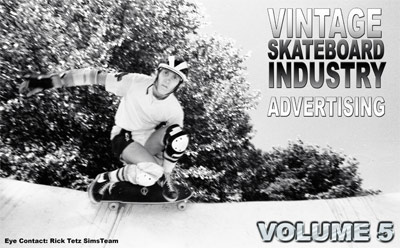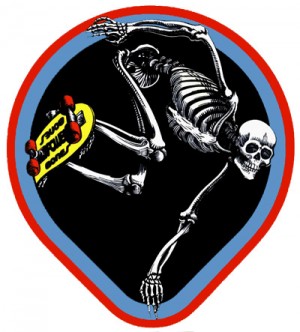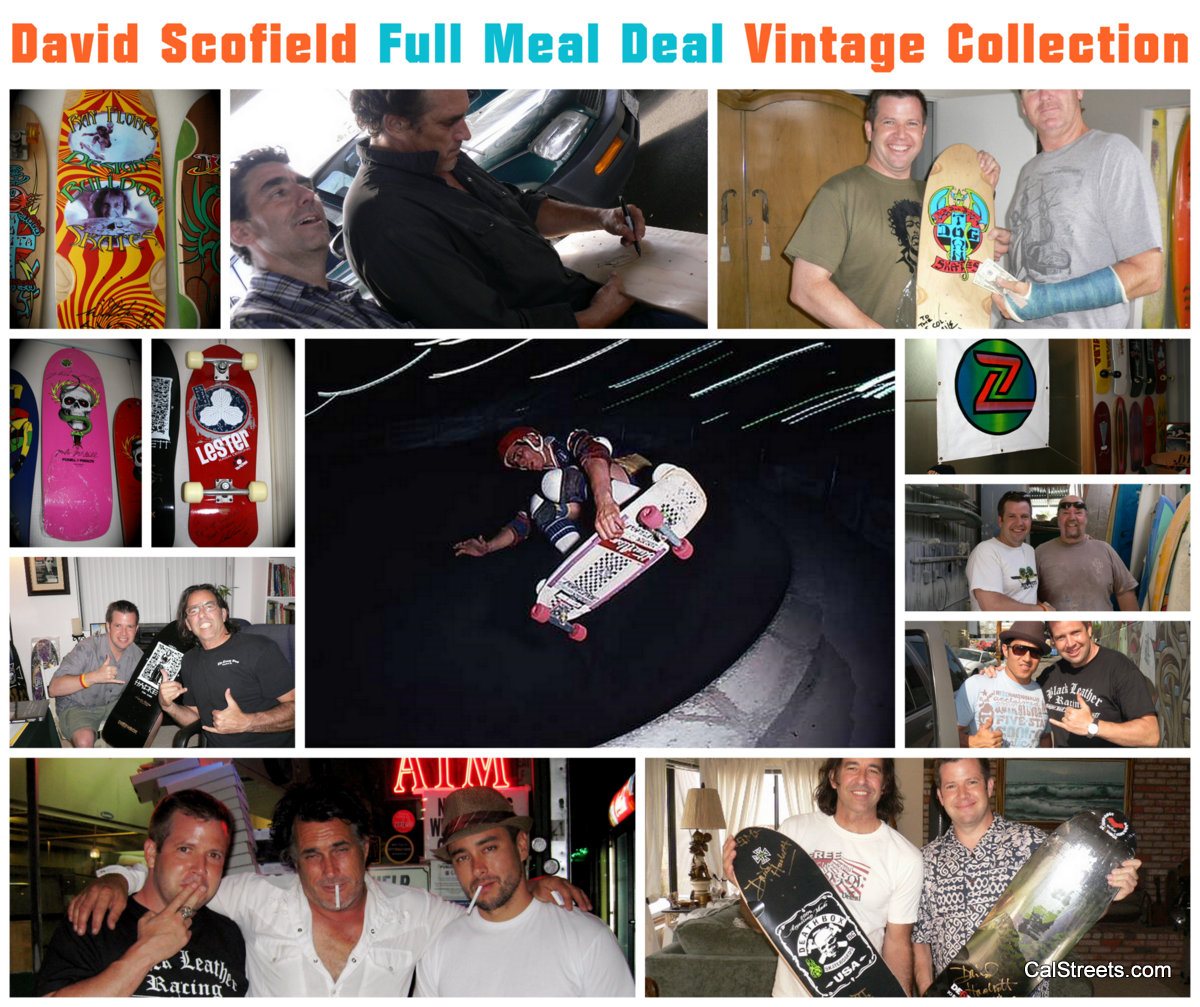Archive

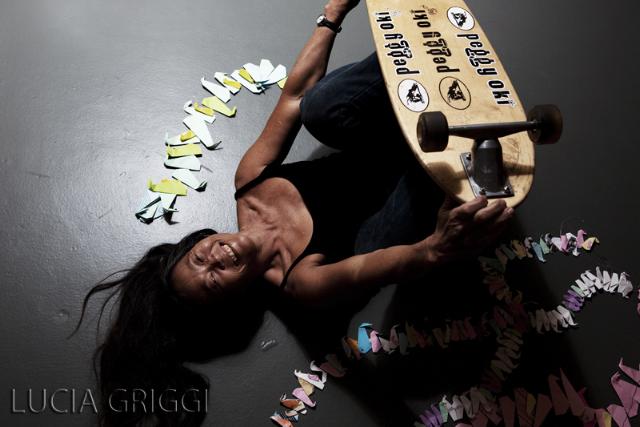 Here’s and interview with Peggy Oki Straight out of· ‘The Skateboard: The Good The Bad And The Gnarly’ Written By Ben Marcus.
Here’s and interview with Peggy Oki Straight out of· ‘The Skateboard: The Good The Bad And The Gnarly’ Written By Ben Marcus.
When and where did you start skateboarding?
That was a long time ago! I would say at the age of around ten, when my father bought my brother and I our own “Black Knight” skateboards from FedCo, fully equipped with Fred Flintstone (stone-age) rock wheels. We skated around the neighborhood which later was named the Territory of Dogtown.
Can you define what “Dogtown” means? The definitions seem to vary from person to person.
“Dogtown” was bordered by Boxer Blvd, Labrador Lane, Beagle Drive, and Poodle Place. And of course, “no outsiders!” OK, just kidding.
Who influenced/inspired/mentored you as a beginner and then as you progressed?
I knew of no influences as a beginner. As I progressed, it was my Zephyr team mates.
How did your boards change as you progressed?
After the Black Knight, a few years later, my brother made a skateboard for me in his woodshop class at Venice High. It was a small swallowtail, set up with Bennett trucks and Cadillac Wheels. So great to be rolling on urethane! And then I got on the Zephyr team and rode the Zephyr skates, eventually Z-Flex.
Describe the circumstances that lead to you becoming a skater for the Zephyr team.
I had begun surfing at Bay St., and was into practicing down Bicknell Hill on the days without surf. While there, I think it was Jay (Adams) who started talking with me and asked if I would be interested in being on a skateboard team. So I went to the Jeff Ho/Zephyr shop up the road, and “the rest is history.”
When did you join and what was it like being a lady among rogues?
I joined as the team was being formed. Being into motocross racing at the time – also a “tomboy” through my girlhood – it was just another fun thing to have skating adventures with the rogues.
You are kind of the Gidget of skateboard world, in a sense?
Hmmm, I’m not old enough to really know a lot about Gidg, other than Sally Field. Were her parents supportive, or not?
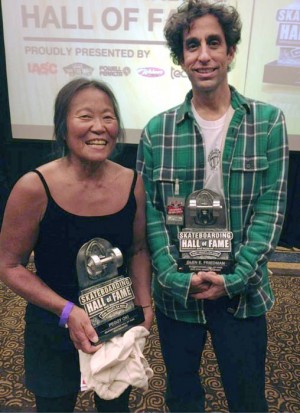 Kathy Kohner’s parents weren’t sure about their teenage daughter coming back from the beach with stories of Moondoggie and the Great Kahoona. But then her dad wrote a popular book that became a popular movie, so I think they were down with it. What about your parents and these rascals you were running around with? Could you bring Tony or Jay home for dinner to meet mom and dad?
Kathy Kohner’s parents weren’t sure about their teenage daughter coming back from the beach with stories of Moondoggie and the Great Kahoona. But then her dad wrote a popular book that became a popular movie, so I think they were down with it. What about your parents and these rascals you were running around with? Could you bring Tony or Jay home for dinner to meet mom and dad?
My father seemed pretty cool, but my mother never approved of the many tomboy activities. Tony or Jay home for dinner?
What was your specialty as a skateboarder and during the 1970s, were there a lot of other women skateboarding?
The hills were fun for downhill and slalom. I loved skating the banks at the schools. I think that like most of the guys on the team: “tricks are for kids.” I didn’t see any other women skateboarding wherever we went.
When did you start to fade away from skateboarding and hanging out with the Z Boyz/Dogtown crew?
I faded from the scene after the first few contests. From the first, the Del Mar, I didn’t like the politics. It wasn’t always about the best skater, and it wasn’t fun for me to hang around all day, hardly actually skating.
Are you surprised by all the media attention that you all got then and now?
No.
In all the documentaries/movies/stories that have been written and produced, do you see anything that is untrue or that has been left out?
In the documentary, it wasn’t shared that for some unexplained reason, I was not “qualified” for the slalom competition at Del Mar. I was the only girl who made it down the ramp both times in the trials. In the movie, much of the story was fictionalized. Jay’s mother was not as she was portrayed.
Just for the heck of it, let’s play a word association game. I’ll name all these Z Boyz/Dogtowners and you sum them up in a word or a sentence
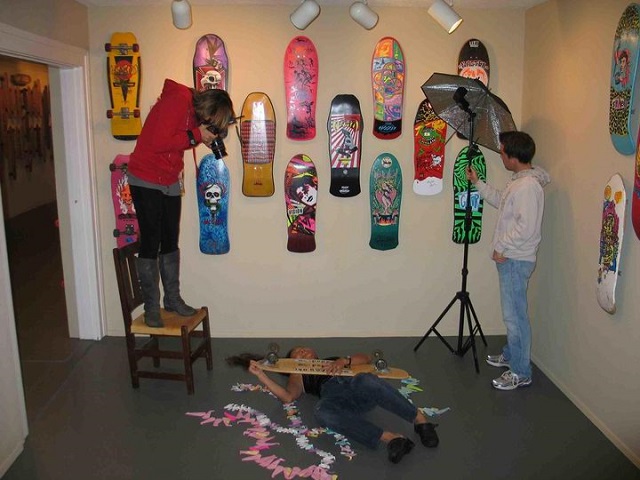 It’s hard for me to play this, but will do what I can. Everyone is a unique individual. And our focus was to skate when together. We didn’t have much discussion to get to know each other personally.
It’s hard for me to play this, but will do what I can. Everyone is a unique individual. And our focus was to skate when together. We didn’t have much discussion to get to know each other personally.
Jay Adams: remarkable and not repeated since
Bob Biniak:
Chris Cahill: hardly actually
Paul Constantineau: PC
Paul Cullen: BPC
Skip Engblom: colorful, intellectual, humorous, caring
Jeff Ho: Jeff
Wes Humpston: hardly recall
Shogo Kubo: A lot of people thought we were siblings.
Jim Muir: Muir
Stacy Peralta:
Nathan Pratt:
Allen Sarlo: Big Hugs
Craig Stecyk:
You didn’t include Tony Alva
And Wentzle Ruml A pleasure to learn nowadays that Wentzle cares about the environment also.
You came to the shoot with origami whales and now you are in Dominica with those whales. What is it you are doing there?
Dominica, the only East Caribbean IWC member nation that does not support Japan’s whaling interests, has recently renewed its commitment to whales. So the Origami Whales Project is currently working with children and conservation groups to create a special Curtain of Origami Whales to remain on exhibit there to symbolize (and hopefully galvanize!) the country’s position of protecting whales. We are planning to coincide this effort with a premier screening in Dominica of “The Cove” (which to date has received 24 awards and is on the Academy Awards nominations “shortlist” for 2009 Best Documentary film) in early 2010. Charles Hambleton, Head of Clandestine Operations for “The Cove”, who I worked with this summer, plans to be here as well. Here is the link to my soon-to-be-posted “blog” page: http://www.peggyoki.com/
How long have you been doing this?
Since 2004, so now six years.
What kind of whales pass through Dominica?
Sometimes Humpbacks and Pilot Whales. The very special thing about Dominica is that there are about five families of sperm whales that spend a lot of time around the waters of Dominica. They are a pelagic species, usually found far from shore in deep ocean environments. So to have them so close to any land is unique. I just so happen to be a “Sperm Whale Groupie”.
I like whales. They go past my house in Malibu sometimes.
My guess is that you see the Gray Whales on their migrations to and from Baja where they are calving and nursing. There are actually lots of other species off the California coast, but generally not seen as close to shore.
Can’t imagine how people can kill them.
Whaling is cruel and unnecessary. If people knew what happens, it would be shocking. There are laws in many “civilized” nations regulating the “humane slaughter” of farm animals. The International Whaling Commission (IWC) has NO regulations on this issue. Sometimes whales may take OVER AN HOUR to die. Due to their highly adapted physiology, it’s actually hard to know when a whale is actually dead.
CALSTREETS VAULT COLLECTION- STICKERS
200+ Vintage Skate Sticker Collection 70’s 80’s Thankyou to all my amazing sponsors from the past, great to connect with everyone again. SPONSORS: KADE CYCLE (Cranbrook skate team 1975), BENGEL BOARDS, HOBIE, RECTOR, VANS, VISION, WINGS WHEELS, GULLWING TRUCKS and of course SIMS!
Skating since the 70’s I have acquired many stickers, here is a gallery of some of them.
 Mr. Powell Explains the Evolution That Lead to Bones. Lucia Griggi took a couple of great portraits of George Powell as this book was getting started, and then I didn’t bother him again until early September. I was fiending to turn in Chapter Five of this book – which had grown to 100,000+ words – but it would not be a complete book without talking to George Powell about the rise of Powell Corporation, the Powell-Peralta partnership and the first products he produced. George Powell is an engineer and he interviews like one: Technical, knowledgeable, informative. Very good spelling and punctuation.
Mr. Powell Explains the Evolution That Lead to Bones. Lucia Griggi took a couple of great portraits of George Powell as this book was getting started, and then I didn’t bother him again until early September. I was fiending to turn in Chapter Five of this book – which had grown to 100,000+ words – but it would not be a complete book without talking to George Powell about the rise of Powell Corporation, the Powell-Peralta partnership and the first products he produced. George Powell is an engineer and he interviews like one: Technical, knowledgeable, informative. Very good spelling and punctuation.
Hollywood, California: 1943
Where did you grow up?
Mostly in West Hollywood, near Santa Monica and La Cienega until I was nine, then moved to Burlingame for three years, then back to Hollywood.
Were your parents/ancestors involved in engineering/manufacturing in any way?
No history of technical interest from my mom, grandparents, or step dad, but my genetic father studied engineering and eventually became a contractor, building some of Ventura and Oxnard’s marina complexes.
Did you surf before you skateboarded?
Actually, no. I skateboarded when I was about 12 to 13 on a home made 2×4 with my metal clamp-on roller skates on it.· I still remember throwing away my skate “key.”· I bought my first surf board ( a Dave Sweet foam and fiberglass model) in about 1959.
What was you first skateboard?
Made it myself out of a found 2×4, some screws and my old metal wheel clamp-on roller skates.· I rode it all by myself for about a year until I wore the wheels off it and gave up.
What was your evolution in skateboards, through the 60s/70s?
When skateboarding became popular in the 1960s, my wife and I saved up our Blue Chip stamp books to acquire two Hobie Super Surfers, which we rode around the inner quadrangle at Stanford during the evening hours when no one was there to complain.
Where did you attend high school?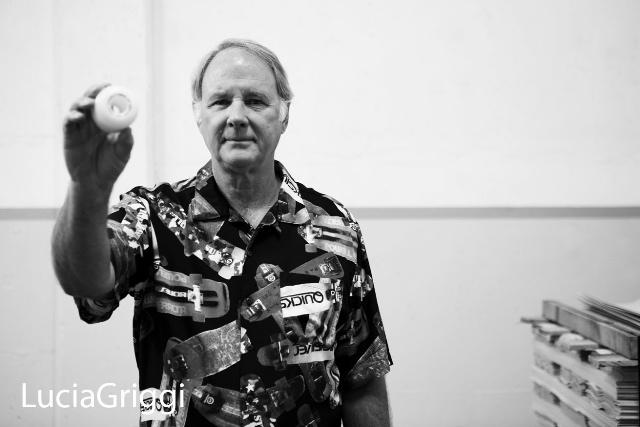
I went to Hollywood High.
What kind of engineering were you studying at Stanford?
Mechanical Engineering and Product Design.
Did you compete or were you involved with skateboard organizations at all?
No, I didn’t even know if any existed in the 60’s.· I thought skateboarding was perceived as a mass market product for kids at the time and there was no real industry or culture that had spread to Palo Alto as far as I knew.· I just remembered how much fun I had had on my home-made board and really wanted to try a “factory made” board.
What jobs did you have after graduation and leading up to your involvement with skateboarding?
After getting my masters degree in Product Design, I went to work for Hewlett Packard in Palo Alto.· Then worked for FMC, DTL which was a defense contractor.· It was here that I first used urethane in a product design.· Next I worked for a small electronic company to develop a new kind of instrument housing that could be put into an electronic rack and also be portable.· Lastly, I worked for Raychem, as an area manager (sales engineer) trying to apply Raychem’s technology to various high tech projects being worked on in the aerospace industry in LA.· I pissed off my boss and got laid off from this last job, and this was what prompted me to “go for it” by starting a company to produce the skateboards I had been playing with in my garage for about two years.
Did you like working for companies, or did you yearn to have your own deal going?
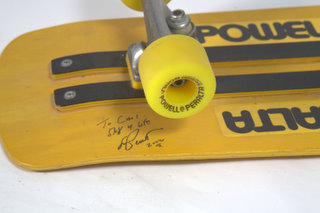 I have always been very entrepreneurial.· A fellow student and I started a company while we were at Stanford, making custom, artsy candle holders, lamps, lighting fixtures, and room dividers.· We bought welding torches and steel sheet, rod, and tube and had a lot of fun with that.· It was called Studio West.· That taught me many practical lessons.
I have always been very entrepreneurial.· A fellow student and I started a company while we were at Stanford, making custom, artsy candle holders, lamps, lighting fixtures, and room dividers.· We bought welding torches and steel sheet, rod, and tube and had a lot of fun with that.· It was called Studio West.· That taught me many practical lessons.
What wheels were on the market prior to Bones? It would be good to list the origins of wheels in order if that is possible: Cadillac, Stoker, Road Rider, Oj, Park Rider and then what?
The main things that got me back into skateboarding in my 30’s were my son Abe – who wanted to skate – the urethane wheel – which had just come out – and the primitive nature of skate equipment in the mid 70’s, which encouraged me to see if I could do any better. Urethane wheels were an instant success everywhere they were introduced, because they gripped so well.· Every skater who saw and tried a urethane wheel, including myself, took about 10 seconds to know that they were riding a completely new vehicle, which could do things a clay-wheeled skateboard could never do.· It was one of those paradigm changers that happen only seldom in the history of any sports or technology.· An analogy might be the shift from steam power to electricity at the turn of the 20th century.· I’ve always paralleled the composition to urethane jump to the Aztecs seeing horses for the first time, or the Vikings deciding that sail power wasn’t for wussies.
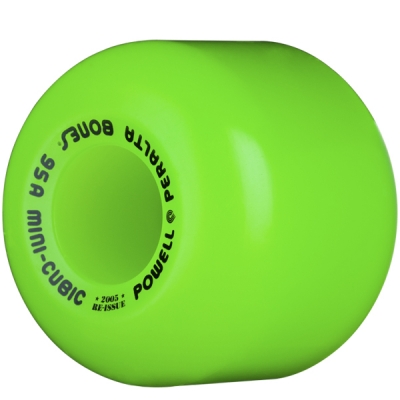 The urethane wheel was a single component, so good, that it changed the entire performance envelope of the skateboard – changed skateboarding forever – and it was the single invention that enabled our entire industry and sport to develop. In 1975, my son Abe and I were riding together in the Pacific Palisades, and I noticed, as I would return to the Palisades Hobby store for new wheels or components, that skateboarding must be exploding, because every few weeks there would be a new brand of wheels, trucks, and decks on the shelves.· I think skaters must be natural entrepreneurs, because everyone seems to want to get into the act, somewhere in the industry, I guess because we are more independent, and risk takers.
The urethane wheel was a single component, so good, that it changed the entire performance envelope of the skateboard – changed skateboarding forever – and it was the single invention that enabled our entire industry and sport to develop. In 1975, my son Abe and I were riding together in the Pacific Palisades, and I noticed, as I would return to the Palisades Hobby store for new wheels or components, that skateboarding must be exploding, because every few weeks there would be a new brand of wheels, trucks, and decks on the shelves.· I think skaters must be natural entrepreneurs, because everyone seems to want to get into the act, somewhere in the industry, I guess because we are more independent, and risk takers.
Frank Nasworthy’s Cadillac wheels from Virginia were soon challenged by wheels made in west coast urethane shops, offering different shapes and colors.· Then Santa Cruz introduced a wheel which used precision bearings instead of the “loose ball bearings” we all enjoyed chasing around the floor, or searching in the grass for, as we cleaned them.· Next, Tom Sims introduced larger diameter, thin-lipped red wheels that challenged Santa Cruz’s new Road Rider wheels, and the exploding industry quickly changed to precision bearing wheels.· It was at this point in 1975 that I started to develop wheel and deck designs of my own in my garage and kitchen.· As I progressed, I took my designs and formulas to urethane processors to pour formulas I could not pour in my kitchen.
By the fall of that year, I had analyzed existing wheel designs and decided that they were not optimum for skating outside, and that skate wheels should have stiff edges and large radiuses on both edges of the wheel to help them roll over cracks, twigs, and transitions.· I made a few molds, poured some wheels and tested them.· I thought they had promise, so I applied for a patent on this new design for skateboard wheels, and received a patent on the Double Radial wheel as I called them.· Skate wheels are no longer called Double Radials, but in fact they are the natural evolution of the wheels I developed in 1975.
During 1975 I was also developing deck designs and experimenting with materials and shapes I thought might be better.· I met Tom Sims one day at Palisades High, as I was testing new designs, and he was doing a photo shoot for the Heinz Annual Report.· They asked Tom to skate down the parking lot flying an American flag, so you can see that skateboarding was already being recognized by corporate America as an up-and –coming, cool thing to do.
Tom and I eventually agreed to jointly market a new slalom deck if I developed one better than the G&S Fiberflex.· Just about the time I finished this project, working part time on weekends and evenings, the company I was working for laid me off, freeing me up to focus full time on my new skateboard designs. Tom and I jointly marketed my first commercial deck design, the Quicksilver.· This was a very modest success, but I needed more products to keep my baby business alive.· So I took some prototypes of my double radial wheels to Tom, in the hopes that he would want to co-market my wheel design too.
When I first showed Tom my first double radial wheels, he gave them to his team to test.· They said that they could not see any big difference, and they thought his Comps were just as good or better than my new wheels.
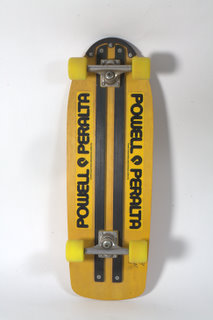 This initial failure lead me search for ways to improve my wheel performance.· I had found an interesting new formulation by researching urethane company catalogs, but had found no one who could pour it yet, because of its different urethane to curative ratio, and the difficulty of mixing the two components properly. Thus, I had to use the same urethane everyone else was using for my first prototypes.· Now I set out to find a processor that could pour this very different chemistry.· I looked on the west coast, but since I was not having any luck, the CPR Upjohn sales office in LA was willing to pour me a few test sets in my double radial molds, so I could evaluate the material.· When I got them, they were translucent white, as that was this material’s natural color – instead of the clear, natural amber color of the urethane in use at the time.
This initial failure lead me search for ways to improve my wheel performance.· I had found an interesting new formulation by researching urethane company catalogs, but had found no one who could pour it yet, because of its different urethane to curative ratio, and the difficulty of mixing the two components properly. Thus, I had to use the same urethane everyone else was using for my first prototypes.· Now I set out to find a processor that could pour this very different chemistry.· I looked on the west coast, but since I was not having any luck, the CPR Upjohn sales office in LA was willing to pour me a few test sets in my double radial molds, so I could evaluate the material.· When I got them, they were translucent white, as that was this material’s natural color – instead of the clear, natural amber color of the urethane in use at the time.
When I rode this new formulation, I was super stoked, because they were a huge improvement.· The new white, MDI chemistry was much faster and more responsive because of its higher resilience.· When I took the wheels to the Tea Bowl in Santa Barbara to have other skaters ride them, they generated a lot of excitement and I knew I was on the right track.
My next problem was to find someone who could process this new material properly, because virtually no one I knew of had equipment that was accurate enough to produce good results with a 1,4 BD cured MDI.· Ironically, I ended up at Creative Urethanes, the processor who had produced the Cadillac wheel several years earlier, but lost his business to west coast processors, because the skateboard business was centered in SoCal and Frank Nasworthy had not shifted to precision bearing wheels when his competitors did.· Vern Heitfield, the owner of Creative Urethanes, swore he could process this material with his self-constructed pouring equipment, “no problem.”
This turned out to be not true in the end, and cost both of us a lot of time and money.· I eventually despaired after a couple of years, and started looking for another processor, that had purchased the kind of equipment I thought would process this material.· The only one available was Rogers Manufacturing, and they turned out to be located in Huntington Beach.
In about 1980, Roger agreed to take over my production.· From there, we finally began to gain serious market share because of our Bones’ wheel’s quality and performance.· Powerflex had actually beat me to market with a quality MDI wheel, poured by Rogers, in multiple colors, because I had wasted two years trying to get good product from Creative Urethanes, and now I had lost my lead to another company.· I was not stoked, but I had developed new formulas that were unusual, and proved to have better wear, rebound and hardness control, so I eventually regained leadership.
Can you get technical for the layman about the differences between TDI and MDI. I think TDI was the chemical that caused Grubby Clark so much trouble at Clark Foam. The Orange County Hazmat people were afraid he was going to spill a load of the stuff and kill everyone in Laguna Niguel.
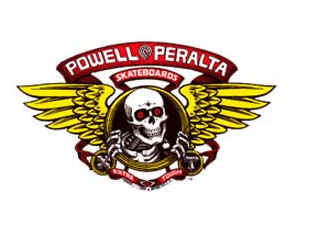 It is the isocyanate by itself that is a major problem with TDI.· If you breathe the fumes or have it touch your skin too much, you may become “sensitized” and develop rashes, lung disease or whatever… none of it good, and so great care must be taken in processing urethanes in general, but certain types like TDIs especially.· MDI is said to be inherently less toxic, but when you make wheels, you don’t have to work with the raw isocyanate, unless you choose to, and your material is reacted with other materials into an inert state very quickly, but TDI and the MOCA it is cured with are still very controlled substances.
It is the isocyanate by itself that is a major problem with TDI.· If you breathe the fumes or have it touch your skin too much, you may become “sensitized” and develop rashes, lung disease or whatever… none of it good, and so great care must be taken in processing urethanes in general, but certain types like TDIs especially.· MDI is said to be inherently less toxic, but when you make wheels, you don’t have to work with the raw isocyanate, unless you choose to, and your material is reacted with other materials into an inert state very quickly, but TDI and the MOCA it is cured with are still very controlled substances.
It is not helpful to go into the differences in the urethane chemistry or molecular structure unless you are a polymer chemist, and I am not.· Perhaps it is useful to say that TDI was an earlier chemistry, and had found good use in products like fork lift tires, pallet jack wheels, industrial casters, and industrial items.· I believe roller skate rental wheels, and subsequently skateboard wheels, were among the first sports to use polyurethane.· The newer MDI materials had a slightly different structure, which allowed them to be cured with Diol curatives, which were not as dangerous to work with as the amine curatives used with TDI at that time. You might not want to print all of that…
What was different about the Bones formula. Design, manufacturing, marketing?
The Bones Double Radial shape was new, superior, and patented.· Our white MDI based formulas were the first and best on the market, and far superior to the 90-95A TDI wheels competing with us.· If we had been able to produce quality wheels from the beginning, we would have succeeded in the wheel market immediately, but instead, we tempted the market with higher performance samples, but had uneven production quality for the first two years, most of which I refused to ship.
The name I chose for the wheels, BONES®, was based on the natural bone white color of the MDI materials I was using, and lead to the use of skeletons and bones in our marketing.· This turned out to be popular with skaters, and added to our reputation, if not our sales.· As the years went on, we continually improved the rebound, abrasion resistance and hardness range of the wheels, always leading in urethane technology, never following.
Powell-Peralta came into the market just as it was booming, but on the verge of an even faster collapse. How did Powell-Peralta weather that boom and bust as the 1970s got closer to 1980?
The start up of “The Powell Corporation” in 1976 was a very small, naive endeavor.· I had one product, a small factory of 1100 square feet that my family and I lived in for the first few months as we moved from the Palisades to Santa Barbara.· My brother-in-law, Vernon Courtlandt Johnson (VCJ) was my first employee other than my wife Christie, who did the books in her spare time.· Court and I built all the equipment and fixtures we needed to start producing Quicksilvers, and he ran the production shop.
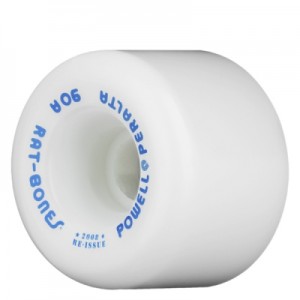 A good friend of mine, Michael Burridge, designed the original triple P logo, the Powell logo, Quicksilver logo, and Bones logo.· Michael also did our first ads that featured studio shots of my products and Tom Sims skating.· For marketing, I tried to sell them directly to skaters because they were more expensive than other skateboards and I didn’t think skaters would pay as much as a normal distribution mark up would add to the cost.· Ultimately, my direct sales, pyramid marketing scheme did not work, and Tom Sims encouraged me to just sell decks to his distributors and allow them to mark the boards up, telling me convincingly that they could sell 10 times as many decks this way, even at the higher price.· He was right, and we switched to what was considered normal distribution at that time and raising the price from $30 to $40.
A good friend of mine, Michael Burridge, designed the original triple P logo, the Powell logo, Quicksilver logo, and Bones logo.· Michael also did our first ads that featured studio shots of my products and Tom Sims skating.· For marketing, I tried to sell them directly to skaters because they were more expensive than other skateboards and I didn’t think skaters would pay as much as a normal distribution mark up would add to the cost.· Ultimately, my direct sales, pyramid marketing scheme did not work, and Tom Sims encouraged me to just sell decks to his distributors and allow them to mark the boards up, telling me convincingly that they could sell 10 times as many decks this way, even at the higher price.· He was right, and we switched to what was considered normal distribution at that time and raising the price from $30 to $40.
By 1977, slalom decks like the Quicksilver and G&S’s Fiberflex were at the end of their popularity.· Rigid decks that were better for skating banks, pools, and ditches were the best sellers, so I developed Quicktail, a thicker version of the Quicksilver with a small kicktail.
I formed a small team of skaters to promote my decks and Bones Wheels, with Ray Rodriguez as my top skater.· Ray became so associated with Bones wheels that he is still known to this day as Ray “Bones” Rodriguez.
Okay that answers that mystery. I thought Bones were named for Ray Rodriguez. Thanks.
In 1978, Stacy Peralta left G&S and eventually joined me to create a completely new team and to help me build the company.
Stacy’s efforts were so successful in attracting the best young skaters of the day that he soon had all the up and coming young guns riding for us.· When I realized how helpful and important Stacy was in marketing and promoting our products, I agreed to begin marketing all our products under a new name, Powell•Peralta.
Stacy also convinced me that decks with flex were going out and suggested we switch to laminated wooden decks, so I started working to optimize a new wooden construction and developed crazy, fluorescent-dyed decks with a combination of hard and soft maple I called Brite-Lites.· Stacy also recommended a deck laminator in Michigan that he had met, and who had developed a new construction we ended up marketing as the Beamer.· This was the only deck we did not develop ourselves, and while it had important advantages and was very popular, it was very difficult to produce and eventually developed an additional Achilles Heel: When pool coping grinds became popular in the late 70’s, the grinds would soon wear through the fiberglass reinforcing beams and then the deck became a 3/8” thick 5 ply…which was no longer strong enough.
About this time skateboarding just died, and everyone was having problems shrinking fast enough to stay alive.· As Stacy points out, skateboarding collapsed in mid-1979, and just got worse and worse until the fall of 1983.· In reality, the fact that we were small, and doing less than two million dollars per year by the end of the 70’s probably made it easier for us to survive, than if we had been as big as Sims or G&S at that time.
We were forced to go from small and growing to smaller and clinging on by our fingernails.· I am often doggedly determined, and in this case it proved a valuable trait.· I had committed to skateboarding, and loved it.· I just couldn’t imagine not being in the skateboard business, so my family and I just toughed it out.· We missed many payrolls, defaulted on bank loans, relied on family loans and personal savings to make the rent.· Stacy left to work in Hollywood, so he could make a decent salary, and ran the team virtually for free.· During those years our sales dropped 50% to about one million per year, and getting everything done to keep our company going was sort of a magic act…or at least sleight of hand.
One sleight of hand was the ironic conversion of indoor roller skate wheels from their original amber
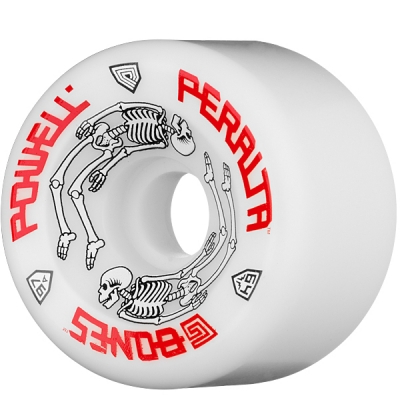 TDI formulas to Bones MDI wheels.· Roller skaters discovered our superior skateboard wheels and wanted to use them – just like skateboarders had borrowed TDI wheels from roller skaters ten years earlier.· Ever since, we have maintained a good relationship with roller skaters, through our urethane formulas.· It was this relationship that probably saved our company from 79 to 83, when skateboarding was experiencing its Dark Ages, and there were only enough skaters to ‘sort of’ support five companies.
TDI formulas to Bones MDI wheels.· Roller skaters discovered our superior skateboard wheels and wanted to use them – just like skateboarders had borrowed TDI wheels from roller skaters ten years earlier.· Ever since, we have maintained a good relationship with roller skaters, through our urethane formulas.· It was this relationship that probably saved our company from 79 to 83, when skateboarding was experiencing its Dark Ages, and there were only enough skaters to ‘sort of’ support five companies.
Well I consider the late 1970s/early 1980s the Second Dark Ages. The first was the late 1960s, up until urethane. Then, just when we thought things were never going to improve and we were pondering how to continue on, the market suddenly began to improve dramatically, at back to school time in 1983.· A whole new generation of skateboarders “discovered” skateboarding, and we were off again.· Suddenly, we went from making perhaps 500 boards per month to as many as we could possibly produce for the next four years, never meeting demand.· This was when we brought laminating into our production area so we could better control the quality of our decks, and increase production. We never really caught up with deck production until about the time of the Animal Chin video in 1987.
Since we were subcontracting our wheels at that time, however, we were able to meet our wheel orders for Bones wheels, and this helped us to grow. A couple of years later, we purchased Rogers Manufacturing, and integrated the complete wheel process into our production facility in Santa Barbara, where it still exists today.
You went from zero in 1975 to $2 million in sales in a few short years, which is not bad. At what point did you realize that skateboarding could be a significant business?
Boy, when I first started my little company I figured I would be successful financially very soon, like all young inventors and entrepreneurs.· But after struggling for four years, until the industry crashed, and never making a penny more than grocery money, I began to think I might never succeed in creating a viable skateboard company.· After another four years, the industry rebounded, and things started to look up a little.· We were able to repay our loans and start to grow.· So the first eight years were a bust financially.· The next 10 were a wild crazy ride that probably only happens once in a lifetime if you are lucky.· Stacy and I thought we were going to become reasonably wealthy, own homes, cars, send our kids to good schools, all that stuff, and we had a lot of fun.· Then in 1993, we crashed and burned completely, losing all our gains.
Can you give a verbal graph of how your sales increased?
We went from making 50 decks and 0 wheels per month in 1976 to 1,000 decks and perhaps 10,000 wheels per month in 1979, and then back down to about 500 decks and 2000 wheels per month during the first few years of the 1980s.
How many buildings did you lease/buy from 1975 and how many employees did you have at your peak?
We had only one building at a time, but moved three times, each time to a slightly larger building.· The maximum number of· employees during this period was about 20.
Do you have any regrets from this first five years, or were you smart and lucky and all good things.
I was dumb, and incredibly lucky during the first eight years, just to survive.· It was an intense learning period with no financial reward, only loss.
GREAT BOOK HOT OFF THE PRESS’S: The Skateboard , The Good The Rad, And The Gnarly By Ben Marcus
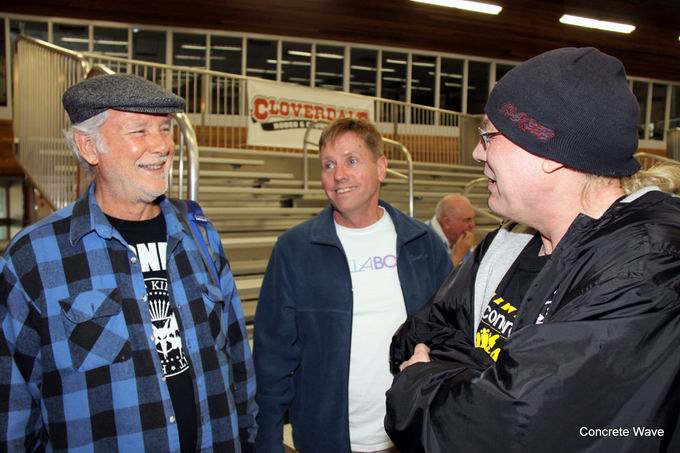 George Powell, (Powell Peralta) Jim Goodrich (Skateboarder Magazine Photographer) and Rick Tetz (CalStreets & Longboarder Labs Founder) at the World Freestyle Roundup in Cloverdale May 2012
George Powell, (Powell Peralta) Jim Goodrich (Skateboarder Magazine Photographer) and Rick Tetz (CalStreets & Longboarder Labs Founder) at the World Freestyle Roundup in Cloverdale May 2012
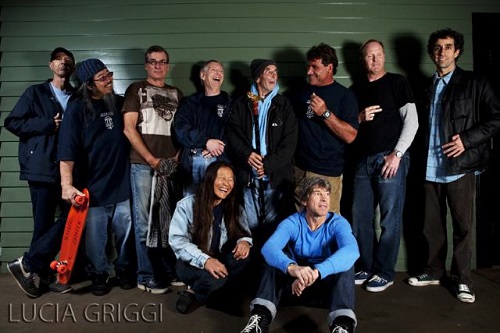 Zephyr, Z Boys, Dogtown. You could write a book. Make a documentary! In 1994, Craig Stecyk III wrote the intro to F%@#% You Heroes, a collection of Glen Friedman’s rap, punk and skate photos from 1976 – 1991.
Zephyr, Z Boys, Dogtown. You could write a book. Make a documentary! In 1994, Craig Stecyk III wrote the intro to F%@#% You Heroes, a collection of Glen Friedman’s rap, punk and skate photos from 1976 – 1991.
That book included a lot of photos of Jay Adams, Tony Alva, Bob Biniak, Paul Constantineau, Shogo Kubo, Stacy Peralta and a lot of other 70s, LA-area skaters, along with Darby Crash, Ted Nugent, Jello Biafra, Henry Rollins, and other skaters, punks and rappers from the LA scene.
F%@#% You Heroes gave a taste of another Friedman/Stecyk collaboration, Dogtown – The Legend of the Z-Boys published in 2000 which Amazon describes like this:
In the early 1970s, the sport of skateboarding had so waned from its popularity in the 1960s that it was virtually non-existent. In the Dogtown area of west Los Angeles, a group of young surfers known as the Zephyr Team (Z-Boys) was experimenting with new and radical moves and styles in the water which they translated to the street. When competition skateboarding returned in 1975, the Z-Boys turned the skating world on its head. . Dogtown The Legend of the Z-Boys is a truly fascinating case study of just how an underground sport ascended on the world. These are the stories and images of a time that not only inspired a generation but changed the face of sport forever. The Legend of the Z-Boys has been described as “The Dogtown text book” and an insightful companion piece to the movie: “DogTown and Z-Boys”. . Spanning 1975 – 1985, the first section of the 240 page 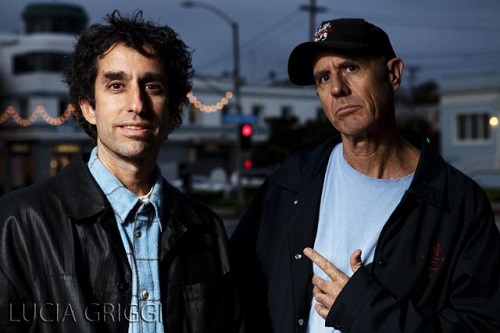 book includes the best of the “DogTown” articles written by C.R. Stecyk III as they originally appeared in SkateBoarder Magazine. The second half compiles 100’s of never before seen skate images from the archive of Glen E. Friedman – many of which appear in the movie.
book includes the best of the “DogTown” articles written by C.R. Stecyk III as they originally appeared in SkateBoarder Magazine. The second half compiles 100’s of never before seen skate images from the archive of Glen E. Friedman – many of which appear in the movie.
There have been books, but there also have been documentaries on the impact of these young LA-area skateboarders in the 1970s. Most famously, Stacy Peralta’s Dogtown and Z=Boys in 2001 was the darling of the Sundance Film Festival and might have been partially responsible – along with Michael Moore – for launching the tsunami of documentaries that have come sense. In 2008, Peralta admitted to Steve Olson in Juice Magazine that Dogtown had sold over one million DVD and over 700,000 VHS.
Those kind of numbers attract Hollywood and that lead to the movie version of the documentary, Legends of Dogtown, which was released in Dogtown did well enough to inspire the feature film Lords of Dogtown, written by Stacy Peralta, and featuring Emile Hirsch, Heath Ledger and Rebecca de Mornay. Roger Ebert loved the doco but the movie, not so much:
Now we have “Lords of Dogtown,” a fiction film based on the very same material and indeed written by Peralta. Not only is there no need for this movie, but its weaknesses underline the strength of the doc. How and why Peralta found so much old footage of skateboarding in 1975 is a mystery, but he was able to give us a good sense of those kids at that time. Although Catherine Hardwicke, the director of “Lords of Dogtown,” has a good sense for the period and does what she can with her actors, we’ve seen the originals, and these aren’t the originals. Nobody in the fiction film pulls off stunts as spectacular as those we see for real in the documentary.
Several books, a very successful documentary and a movie that Roger Ebert didn’t like so much because the skateboarding wasn’t so great, but still featured Heath Ledger doing a scary-good impersonation of Skip Engblom.
Much has been written, re-written, filmed an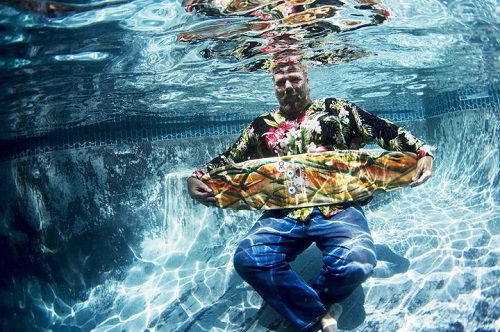 d re-filmed about the time in the 1970s, when the Zephyr Surf Shop in Santa Monica sponsored a surf and skate team who came to be known as the Z Boys.
d re-filmed about the time in the 1970s, when the Zephyr Surf Shop in Santa Monica sponsored a surf and skate team who came to be known as the Z Boys.
It all began with these three chaps, Craig Stecyk, Skip Engblom and Jeff Ho and the short version goes like this: In 1971, Ho, Stecyk and Engblom opened Jeff Ho Surfboards and Zephyr Productions in the Venice Beach area of Santa Monica. These guys were all surfers who were skateboarding out of the 1960s but at first it was all about surfing. Ho and Engblom formed the Zephyr Surf Team, made up of local surfers who had established themselves at the defunct Pacific Ocean Park. As the urethane revolution hit, the Zephyr Skate Team evolved and they became known as the Z-Boys. The original members were Jay Adams, Tony Alva, Bob Biniak, Chris Cahill, Paul Constantineau, Shogo Kubo, Peggy Oki, Stacy Peralta, Nathan Pratt, Wentzle Ruml IV and Allen Sarlo.
Later members included Paul Cullen, Cris Dawson, Jose Galan, Dennis Harney, Paul Hoffman, Donnie Ohem and Tommy Waller.
The team practiced around Jeff Ho’s surf shop and on the streets of Santa Monica and Venice, including the banked walls at Paul Revere and Kenter schools in the Santa Moni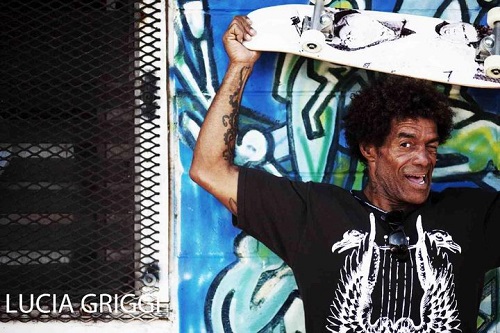 ca mountains and Bicknell Hill, which ran down to the ocean. Moving away from the nose wheelies and 360s and other freestyle moves of the 1960s, the Z-Boys found that urethane wheels and improved equipment allowed them to replicate the “anything is possible” surfing of Hawaiian surfers Larry Bertlemann and Buttons Kaluhiokalani.
ca mountains and Bicknell Hill, which ran down to the ocean. Moving away from the nose wheelies and 360s and other freestyle moves of the 1960s, the Z-Boys found that urethane wheels and improved equipment allowed them to replicate the “anything is possible” surfing of Hawaiian surfers Larry Bertlemann and Buttons Kaluhiokalani.
The Z-Boys skated the banks at Paul Revere, Kenter and the geography-blessed schools of the Santa Monica mountains, they raided swimming pools all over Los Angeles during the drought years of the mid-1970s, and they ran wild in the streets of Venice and Santa Monica – an area dubbed Dogtown by Craig Stecyk.
They were just having fun and not trying to cause a big sensation, but the photography and journalism of Craig Stecyk, combined with their first public appearance at the 1975 Bahne-Cadillac National Championships at Del Mar – launched the Z-Boys into legend.
From: The Skateboard, The Good The Rad And The Gnarly
Written by Ben Marcus Photos by Lucia Griggi
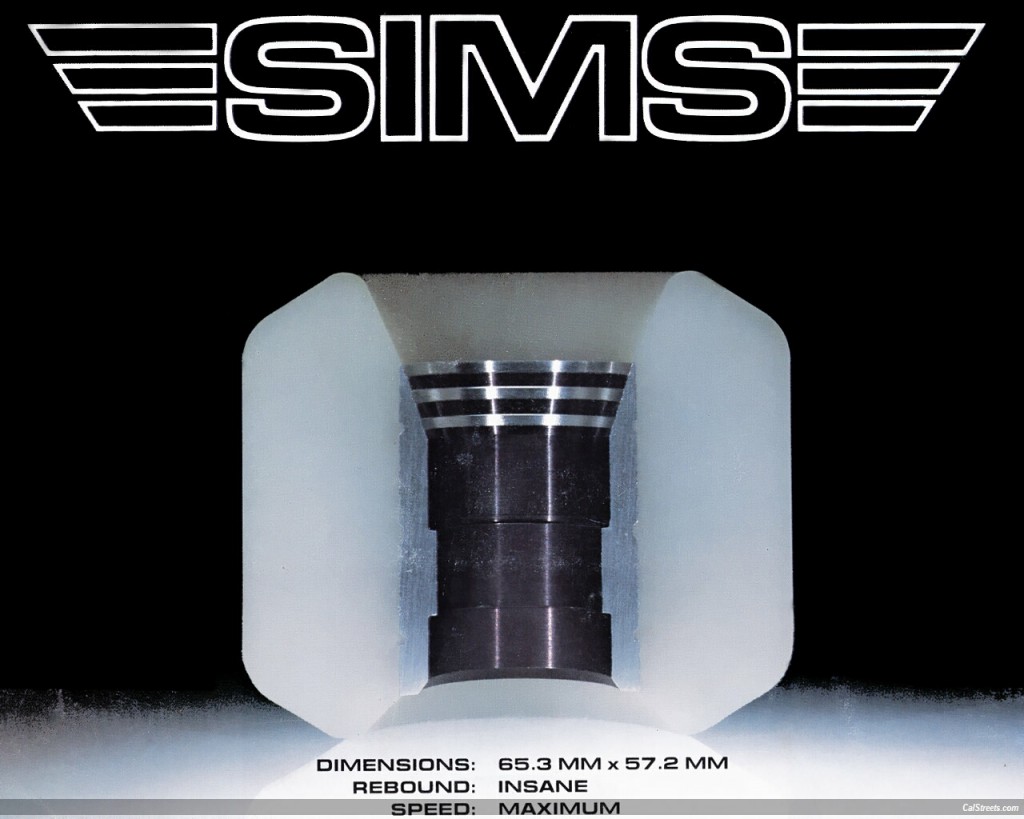 TOM SIMS INTERVIEW PART 1:
TOM SIMS INTERVIEW PART 1:
Here is where I get confused because I seem to think Sims was run by Brad Dorfman and Vision in the 1980s?
By the late 70?s I got very busy getting snowboarding off the ground, and licensed Sims Skateboards to Brad Dorfman in 1981. At the time we had the #1 team with Brad Bowman, Dave Andrecht, Steve Rocco, Todd Swank, Pierre Andre, Chris Strople, Wally Inouye and a lot of the guys who would become very influential in skateboarding. Many of these guys were the Who’s Who of skateboarding. It’s amazing the guys who were on my team and what they went on to do later in life in the board sports world.
Pierre Andre started Etnies, and Steve Rocco took over everything. And another name you can put in there is Dave Swift, who became the editor of a big skateboard magazine. Muir formed Dogtown Skateboards, and Todd Swank formed TumYetos. Lamar went on to form Lamar Snowboards.
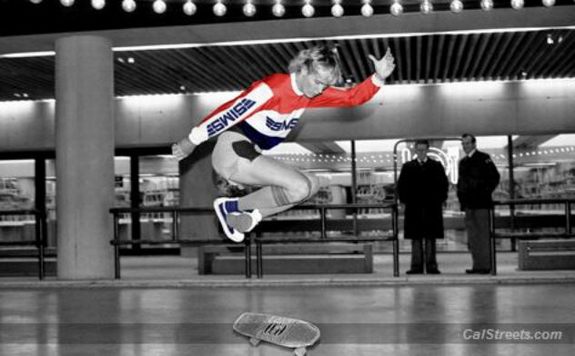 Sims Team Canada: Rick Tetz 1980 – 1st Place Freestyle, CalStreets.com AND Longboarder Labs Founder
Sims Team Canada: Rick Tetz 1980 – 1st Place Freestyle, CalStreets.com AND Longboarder Labs Founder
But at that time, around 1981, I put my focus on snowboarding after Brad Dorfman took over the skateboard license. What’s funny in all of this is that just a couple of weeks ago, Brad Dorfman and Dale Smith made a new deal to license Sims Skateboards. They are spearheading the licensing of Sims Skateboards 25 years later.
When I licensed to Dorfman in 1981 there was a recession going on – 90% of the skate parks shut down and within 18 months skate shops were going bankrupt. And that was gnarly to the major skateboard companies, because it wasn’t COD back then. The bad debt was overwhelming. Stores could not pay their bills, and hundreds of shops and parks went out of business.
That was one of the reasons I licensed to Dorfman. Many of these shops would close down owing us $10,000 or $20,000. When Rocco went to COD, that took the risk out of the skateboard industry. He was smart.
Sims made a big surge in the early 1980s and then we were knocked off the mountain by Powell. Stacy Peralta came on board and built a tremendously strong team and product line with George Powell. He had Steve Caballero and Lance Mountain on the team, and stayed on top some time into the mid to late 80s until 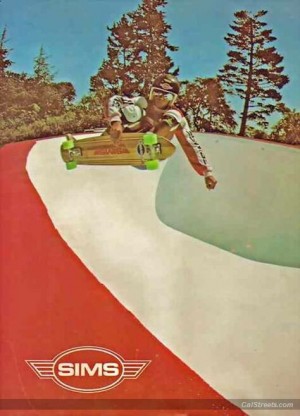 the day Stacy left, and that is the day Powell collapsed. Literally imploded because Stacy, Rodney and most of the team bailed.
the day Stacy left, and that is the day Powell collapsed. Literally imploded because Stacy, Rodney and most of the team bailed.
At this time it was when Steve Rocco left SIMS and Rodney Mullen left Powell, and they joined to form what would become the biggest skateboard company – World Industries, and Plan B. Rodney and Rocco double handedly changed the sport of skateboarding from vert back to the streets.Sims Rocco 1980 – Gary Holl
When I asked a bunch of skateboarders to name transitional skateboards, Gary Holl sent me this image of a 1980s Sims Steve Rocco model. Were you still involved with the company when this board came out, and how is it transitional?
The SIMS Rocco skateboard changed the known universe at the time. Everything in skateboarding was about vertical riding on ramps and in pools, and then Sims introduced the Rocco board and wheel to the world, and it started a full revolution back to streets.
But that was on the cusp of when you were getting out of Sims Skateboards and into Sims Snowboards?
The mid to late 1970s is when the Sims company or product line or team or the whole deal had the most influence on the sports, from the wide decks when we ran our 3 Ways Wide ad. That was a revolutionary ad because the day we ran that ad on the back cover of SkateBoarder, every narrow skateboard in every warehouse and factory and store became obsolete. If I had been a better businessman, I would have unloaded all our inventory before running the 3 Ways Wide ad. It was a huge development, but Alva had a lot to do with skateboards going wider, and you can’t ignore that.
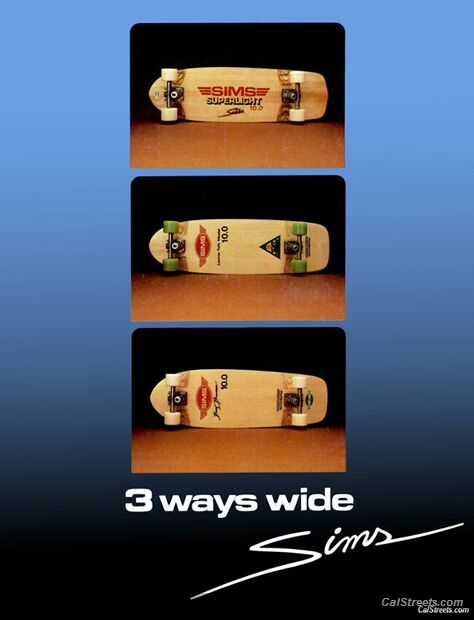 Why is the 3 Ways Wide ad significant?
Why is the 3 Ways Wide ad significant?
This was the first ad showing a wide skateboard. Everything was really narrow prior to this ad. This ad changed the face of skateboarding. This was also the ad I was delivering to SkateBoarder Magazine after which Novak began accusing me of dirty tricks.
What is your side of that “Wonder Boy” story.
I made exactly one trip to SkateBoarder Magazine and that was to deliver the “SIMS 3 Ways Wide” advertisement. I made the drive from Santa Barbara to San Juan Capistrano, because if they received the ad the next day, I would have missed the deadline. When I walked into the room where the production crew was preparing all the ads for blue line, I said “Wow, look at all those ads!
Rich Novak of Santa Cruz Skateboards got wind of my appearance at SkateBoarder Magazine and spun this two-minute appearance into a convenient lie, to disparage me for decades in the skateboard and snowboard industries, and to exalt himself as a ‘knowledgeable’ and ‘safe keeper’ of the sports.
About this ad, Tom Sims said “The Quicksilver advertisement I sent you belongs in the Powell Skateboards section.
This was George Powell’s first advertisement, and we had a handshake deal that SIMS would be his Worldwide Exclusive Distributor. He promised me this enticing deal if I would promote his skateboards and be in his advertisements, and put my endorsement signature on the decks, as SIMS was the most prestigious name in the sport at the time. Without this ad as proof, it would be my word against his.” Ad courtesy Tom Sims.
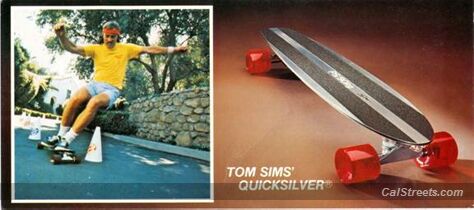 Novak’s other stunts in business are actually far more repugnant. I will not discuss those here.
Novak’s other stunts in business are actually far more repugnant. I will not discuss those here.
One of the reasons Novak was so pissed is because when I ran that ad, all the narrow boards were instantly outdated. If he had known about that ad he would have unloaded the tens of thousands of narrow skateboards he had in his warehouse. Novak was pissed because he didn’t see the wide thing coming. He got caught with his pants down, as did everyone. I should have dumped all my narrow boards at half off. I just wasn’t a greedy enough or savvy enough businessman.
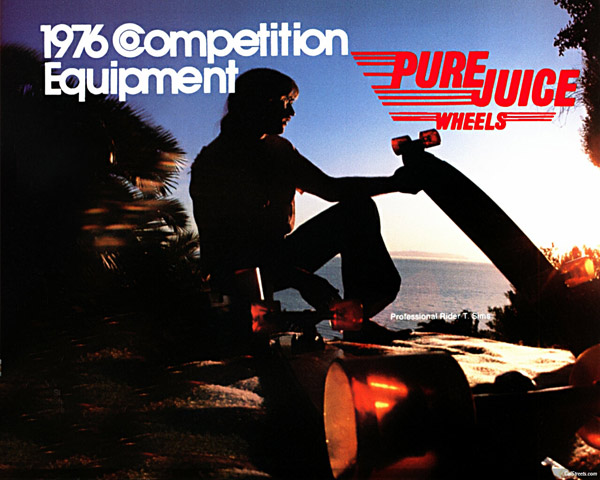 Where are you from originally?
Where are you from originally?
I was born in Los Angeles but grew up in New York, New Jersey and Rhode Island.
Sounds like you learned how to surf here and then were whisked away into exile on the East Coast?
No, we moved when I was two years old. My dad went back there to work at some company and we moved around. Technically born in LA, but grew up mostly in Jersey.
What year were you born?
1950.
This is starting to make sense, based on this whacko theory I came up with in Chapter One, about skateboarding being born in 1947 and then hitting puberty in 1959.
In 1960 we took a vacation back to visit my grandparents in Los Angeles – and to go to Disneyland. I saw some kids skateboarding on the sidewalk, and that changed my whole life. I ran into my grandparents’ garage and grabbed some ancient metal roller skates, cut them in half, mounted them to a 2” x 4” took one run and said: “This is it. I love sidewalk surfing.”
I thought that board was long gone, but then my parents sold that house in Los Angeles – right after the LA Riots.
The Watts Riots in 1965 or the Rodney King riots?
The Rodney King riots. That was 1992. My parents sold their LA house in the early summer of 1992. That’s when I found that 2” x 4” skateboard, which I hadn’t seen since 1960. They were clearing out the house and there was the board sitting there, covered in dust in the garage.
About 10 years later, Stacy Peralta was interviewing me on my ranch while doing filming for the Dogtown movie. He saw the 2” x 4” board and flipped out. He said: ‘That’s the most prehistoric thing I’ve ever seen.’
But that trip from Jersey back to Los Angeles in 1960 is what got me into skateboarding. It didn’t exist on the East Coast and was just starting in LA and southern California. And that lead to everything else that happened to me.
Tom Sims first skateboard. Horizontal view of the 1960s skateboard that launched a 70s/80s empire. Skate courtesy Tom Sims.
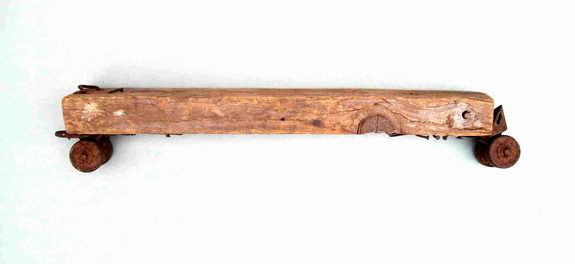 Where in LA was this?
Where in LA was this?
Those first kids I saw were coming down Plymouth Boulevard right near Hancock Park – two blocks from the Ebell Theater on the cement sidewalks. I took a couple runs on my 2×4 skateboard and it worked really bad, but I still could feel the magic. I asked those kids where they got their boards. They told me to go to Sears Roebuck on Pico Boulevard in Los Angeles. My dad got me a Roller Derby or a Roller Sport skateboard, I can’t remember, but I do remember the price: It was $14.99.
I don’t have that board anymore. I took it back east and showed it around to my friends and when I rode it people looked at me like I was an alien. No one had heard of a skateboard or seen a skateboard and you couldn’t buy them for a few years after that on the Eastern Seaboard.
So I had to make my own skateboards when they broke or when my wheels wore out. I was dead without a skateboard. There were good Chicago trucks on my first board. They were durable, but the wheels wore out very quickly. My dad took me to this rough neighborhood in Camden, New Jersey. We went to a roller skating rink to buy wheels which were old used ones off the rental roller skates. The rink manager charged me twenty-five cents for wheels and five dollars for a pair of used old roller skates, which had great trucks.
Composition wheels?
I bought a whole box of used roller skate wheels from that guy. I survived for a long time and started building skateboards for my friends – so I would have someone to go skateboarding with. I was building skateboards for buddies just to spread the fun.
I could make two skateboards from one pair of roller skates. That was my first commercial enterprise – I just wasn’t charging any money.
The hill I lived on was an unbelievably good skateboard hill – just paved with perfect asphalt. I had the ultimate setup growing up – a swimming pool in the backyard with Greenmount Road out front – everyone in town knew that was Skateboard Central.
You were skateboarding your swimming pool?
No we would play Marco Polo after skateboarding for hours on hot summer days. The pool was unskateable due to squared corners.
When did you start surfing?
In 1966 my dad bought me my first surfboard and that’s when my life changed even more, because I had rented surfboards the two previous summers and fell in love with surfing after just one wave. Now I had my own 9’ 4” Surfboards Hawaii nose rider. I was in heaven.
Where were you surfing back there?
The Jersey shore, mostly Long Beach Island and Ocean City.
Even before that, back in 1963 I built the first snowboard. In the winter you couldn’t skateboard everyday in South Jersey, so I tried to figure out how to make a skateboard for the snow. All I wanted to do was go skateboarding so I made a snowboard in woodshop to cure my addiction. I called it a Skiboard, and subsequent wood shop classes kids started to make their own Skiboards based on my design. This is all years before the Snurfer. Haddonfield New Jersey had the only snowboarders in the world for at least three winters until the Snurfer hit the stores in 66/67!
Skateboarding lead to everything for me: Snowboarding, Surfing, Skimboarding and Wakeboarding. I was living a “boarding lifestyle” long before the culture was born.
Where did you live in Jersey?
Haddonfield, across the river from Philadelphia. It’s a wealthy enclave of Colonial homes – where many of the Philadelphia Flyers now live. Haddonfield was a conservative, Colonial town. I got arrested just for skateboarding. I would love to get that police report.
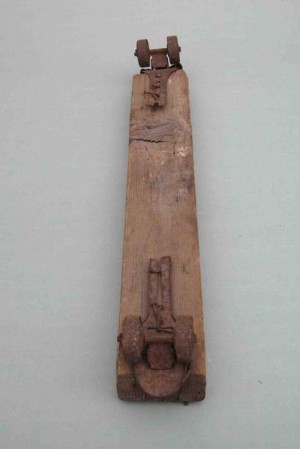 Vertical bottom view of the skateboard Tom Sims made in 1960
Vertical bottom view of the skateboard Tom Sims made in 1960
inspired by kids he saw in the streets of Los Angeles.
Board courtesy Tom Sims.
What year did you get arrested?
Right at the beginning. Right in that 1960, 1961 era.
Skateboarding is not a crime. You could have been the first.
They threw me in the squad car and they didn’t even know what skateboarding was. It was on my record, and my mom and dad were concerned: “What’s that thing you are using in the streets?” I told the police it was a skateboard. They huffed and puffed and kept staring at me as if I was a crook or something.
At what point did your fascination and avocation start to become a profession?
I started building four-foot skateboards in the mid-Sixties, to simulate surfing. At the time, surfboards were all over nine feet long so on those four-foot skateboards I could walk the nose and do kickturns and all that stuff. That went on until the late 1960s, when the short board phenomenon hit surfing in Hawaii, Santa Barbara and Australia. That too changed the world of surfing and even skateboarding. I started building surfboards in my parents’ garage which were the first short surfboards on the East Coast.
Were you doing this all in a vacuum?
I was following Surfer Magazine. I’m trying to think when I first saw a SkateBoarder Magazine. Can’t remember. My magazine collection was lost in a flood some years back here at our ranch.
I moved to California in 1971to find better waves and better skateboard hills, but I can’t remember when I first saw a skateboard magazine. I was just a skateboarder/surfer guy living in the foothills of Montecito outside of Santa Barbara. No TV, no radio – a little adobe hut for $50 a month. No bathroom, no shower. I used a hose for a shower and we had an outhouse.
My whole life revolved around skateboarding, surfing and snowboarding. By the mid 70s, I started building three and four-foot ash skateboards to sell, and my first dealer was the Channel Islands Surfboards shop – ironically now owned by Burton. My second dealer was Val Surf in the San Fernando Valley.
Ironic why?
Because Burton and I became fierce competitors in the snowboarding business years later. By 1976 I was selling Sims Skateboards in Japan Europe and Australia. We had several hundred dealers all screaming for more product. It was really hard to keep up with all the orders.
What were you selling exactly?
Those three and four-foot wood skateboards and then the 30-inch fiberglass boards that were like the Bahne boards. I couldn’t keep up with the wooden boards, but we could do unlimited fiberglass decks from a company in Burbank called Ampul Corp. I remember going to their factory and smelling all the resin and seeing fiberglass dust fill the air.
Basically the fiberglass boards by Bahne, G&S, Sims and Santa Cruz were all very similar until Sims started doing the multiple ply maple boards. My friend – Wee Willy Winkle’s father – had Canada’s largest wooded maple door factory in Toronto. Willy, who was a big Sims Skateboard fan and champion skateboarder in Canada called me up and said: “What do you think about laminated maple Sims Skateboards?”
I jumped on a plane to Toronto and the rest is history.
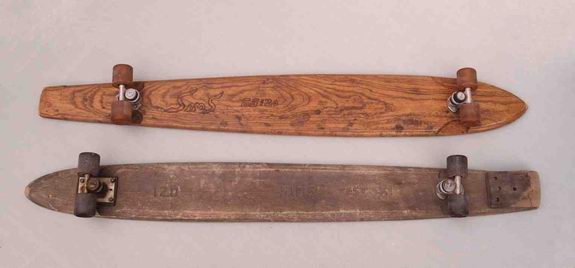 Thus spake Tom Sims: “The bottom board is one of my first production prototype four foot skateboard, which I test rode as one of my personal boards in 1972/73. The four-foot skateboards I had made in the mid 60?s were actually rectangular! The top board is one of the first production boards I was building myself to sell to the surf shops. The wheel wells are likely the very first wheel wells ever. The sand and resin textured top was the first skateboards with grip – which was the precursor to grip tape.” Boards courtesy Tom Sims.
Thus spake Tom Sims: “The bottom board is one of my first production prototype four foot skateboard, which I test rode as one of my personal boards in 1972/73. The four-foot skateboards I had made in the mid 60?s were actually rectangular! The top board is one of the first production boards I was building myself to sell to the surf shops. The wheel wells are likely the very first wheel wells ever. The sand and resin textured top was the first skateboards with grip – which was the precursor to grip tape.” Boards courtesy Tom Sims.
You couldn’t keep up with the wood orders?
I was hiring “Mountain Drivers” (local people from Mountain Drive in Montecito) with band saws to cut them out, and then eventually in the mid 1970s somewhere I had to start buying fiberglass skateboard decks from Ampul. We would silk-screen the Sims name and sold them as ‘completes’.
I was buying skateboard trucks from some guy in Laguna Beach and then some hardware and stuff from Con Colburn down in Venice. I was buying ACS trucks and Metaflex wheels and eventually ACS and Bennetts. And then finally it was just Gull Wing, Tracker and Indy. I have all these old price lists and ads that are kind of classic.
I virtually worshiped skateboarding and the whole experience. So basically what happened was from the early 70s I was kind of a guru of skateboarding. I mastered the hills of Montecito and the Tea Bowl – an iconic skateboard reservoir I found a few miles straight up the mountain from the swanky Biltmore Hotel. There was a huge reservoir built by a wealthy woman in the 1920’s, but it was now empty – luckily for me and my friends. And I was pretty much the undisputed founder and ruler of the Tea Bowl. I believe there is a scene in the movie ‘Freewheelin’ with Stacy Peralta and I at the Tea Bowl.
By 1977 CR Stecyk and SkateBoarder Magazine were referring to me as “The Godfather.” It was around this time that George Powell called SkateBoarder Magazine concerned with all the Sims exposure and said: “Sims must be paying you bribes.” He also said: “Whatever Sims is paying you I will pay more.” Warren Bolster, the editor of SkateBoarder magazine told me this story many times just laughing out loud hysterically.
During this era I was driving down to the different contests in So Cal and winning most everything the Sims team and I entered. That all peaked in 1975 when I won the World Skateboarding Championships.
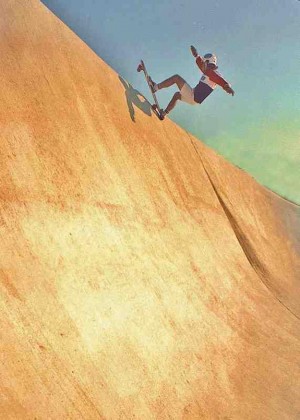 Tom Sims taking one of his mid-1970s longboards to the top of a California reservoir – sucked bone-dry by drought. Photo courtesy Tom Sims.
Tom Sims taking one of his mid-1970s longboards to the top of a California reservoir – sucked bone-dry by drought. Photo courtesy Tom Sims.
Which event was that?
The Hang Ten World Skateboarding Championship down at the LA Arena in September of 1975. When I won there I was on top of the world, then all of a sudden Tony Alva comes along and dethrones me within a very short time. He won the World Championships in a following year and then all of a sudden Alva skateboards were in huge demand. I had to work hard just to sell skateboards after that, because so many wanted Alva due to his mystique and prowess in empty pools just as the Dogtown movie depicts him.
He really was the best pool rider of that era. He changed the whole paradigm for me and the sport. One moment I couldn’t make skateboards fast enough, and then when Alva came along, I had to work to sell skateboards, because everyone wanted Alva. He was an earthshaking phenomenon. Sims dominated the skateboard mags and then Alva came along and took over, there and in the magazines and the business world.
An interesting thing happened just before this time in skateboard history. Many of the Dogtown skateboarders from the Zephyr Team quit Zephyr to join the Sims Team when their sponsor got into difficulties. Jay Adams, Bob Biniak, Jim Muir, Paul Constantineau and Wentzle Ruml all became Sims teamriders – most of those guys were using Sims wheels anyway so when they left Zephyr they came to me: “Will you sponsor me?”
And I was willing to sponsor them – especially Jay and Biniak and the other guys – because they had surfing as their underlying motive for skateboarding. 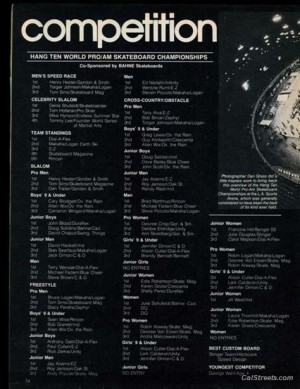 They rode skateboards as if they were surfing and had a style I loved too.
They rode skateboards as if they were surfing and had a style I loved too.
I couldn’t relate to the San Diego skateboard scene – the freestyle thing and only doing 360s and click clacks and this and that. We were looking for banks and bowls and pools. So I related with the Dogtown guys. We did photo shoots in drainage pipes and we’d go to Hemet and all the way to Arizona – to Big Surf in Tempe. We hung out and skated places like the Escondido Reservoir – any ditch or pool we could find.
Many times SkateBoarder or Transworld, or Thrasher Magazine staff showed up as if it was ‘in the wind’ that the Sims team was riding somewhere.
My skateboard team riders were mostly Ventura and Venice-based surfers: Stevie Monahan, Frank Blood, Davey Miller, Richie Vanderwyk and John Drury and the Venice Rats. Lots of those guys were hot surfers, so it made sense for me to sponsor those Dogtown guys for a while. It felt right, and everything was going great and then… Muir busted off to officially form Dogtown Skateboards. I had to say bye to my Santa Monica and Venice crew.
Published in SkateBoarder 2#3, the results of the Hang Ten World Pro/Am Skateboard Championships show Tom Sims placing in the Top Three in three divisions – and also who was riding for who in September of 1975. Ad courtesy Jim Goodrich and Surfer Publishing Group.

